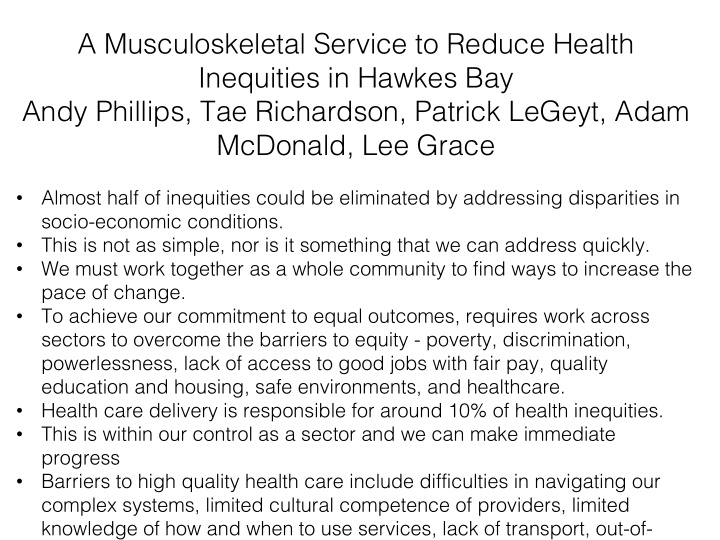



A Musculoskeletal Service to Reduce Health Inequities in Hawkes Bay Andy Phillips, Tae Richardson, Patrick LeGeyt, Adam McDonald, Lee Grace • Almost half of inequities could be eliminated by addressing disparities in socio-economic conditions. • This is not as simple, nor is it something that we can address quickly. • We must work together as a whole community to find ways to increase the pace of change. • To achieve our commitment to equal outcomes, requires work across sectors to overcome the barriers to equity - poverty, discrimination, powerlessness, lack of access to good jobs with fair pay, quality education and housing, safe environments, and healthcare. • Health care delivery is responsible for around 10% of health inequities. • This is within our control as a sector and we can make immediate progress • Barriers to high quality health care include difficulties in navigating our complex systems, limited cultural competence of providers, limited knowledge of how and when to use services, lack of transport, out-of- pocket costs and co-payments for GP services.
Background and Drivers for Change • Musculoskeletal health conditions such as osteoarthritis, rheumatoid arthritis and lower back pain are the he lead eading ng caus cause e of of di disa sabi bility and have a significant influence on health and quality of life. • They affect one in four adults in our community and M ā ori & Pacific adults ely to have arthritis than NM/NP (New Zealand Health are 1. 1.3 3 tim imes es mor ore e lik likely Survey 2013/14) • Comprise at least 25% of total annual health spend Historical and current service pathway inequitable • Evidence of unmet need and unresponsiveness to goals of early intervention • 17% M ā ori (cf total HB population of 26% M ā ori), • 32% lived in quintile 5 (cf total HB population 35% at 2013 census), • Subjective and objective scoring at clinic shows that M ā ori and those from areas of high deprivation have a higher severity of disease at first presentation (greater pain and poorer function)
The Mobility Action Programme for Hawkes Bay • Intentionally delivered to quintile 5 populations in urban centres of Flaxmere and Maraenui and rural centres of Wairoa and Takapau • Partnerships with WINZ and major employers of disadvantaged workers • Care is relationship centred. Consumers access education and support to make decisions and participate in their own care, including self-care • Provides access close to home of early, multidisciplinary, evidence informed care by appropriately qualified practitioners with appropriate values and behaviours. • Kaupapa Maori models of care that are re rele levant, , cus custom omis ised ed to o the he local ocal env envir ironm onment ent and and dev evelop elop cap capacit acity and and cap capab abilit ility of of com communit unities ies. • Care is well coordinated. • Di Dispa parities in access to care and d health outcome mes id ident entif ified ied, re reduced . • Information collected and analysed to enable assessment of patient experience, clinical outcomes and value for money of the services that have been delivered.
Participants Comments • Having the support of co-ordinators and others participating in the programme. • Knowing that I was not the only one in pain – I didn’t feel alone. • The 7 week “Living with pain” course was hugely beneficial, it taught me about mind body and soul and how to look after my needs- not just my physical pain. • It gave me good strategies to deal with my emotions. • The breathing techniques have helped to control my pain which has increased with the cold weather. • I did a course about how to manage clinical pain and conditions- that was really good. • Everyone shared their experiences. • We all got 1-1 time and time to talk in a group, I felt listened to. • I got to exercise again, at the gym and at the pool. • The people that ran the dealing with chronic pain at the Heretaunga Hotel were great. • Going to the gym is very beneficial. • The personal trainer gets us to do the things we can manage and also makes us think about things we can do for ourselves to keep us well. • One chappie was using a stick to walk when he started but now I see him walking without a stick- it’s just great! • The tutors on the pain management workshop were fantastic and very supportive. • Getting assessments and help at last. • When I saw the physio for the first time, she said I should be in hospital already. • The support from the people from MAP was great. They were always calling me to see how I was going .
Co Conclusion We must not tolerate inequities in health outcomes. They are unfair and unjust. It is time to challenge traditional “ways of doing things” and begin to overhaul the system that is clearly working for some better than others. To address health inequities we need to: • Ensure that decisions about the allocation of resources are increasingly taken by communities • Increase investment in prevention and screening programmes that reduce the burden of disease and ill health on our community • Partner with communities, funders and providers to design quality health services and funding policies with the express purpose of achieving equity, holding ourselves accountable through public monitoring and evaluation • Work across sectors to address determinants of health for individuals and communities with coordinated approaches, integrated funding streams, and shared accountability across agencies • Use person and wh ā nau centred care to share power authentically and champion self-determination. T ē t ō ia ia, t ē haum haumat atia ia- Nothing can be achieved without a plan, a workforce and a way of doing things
Recommend
More recommend